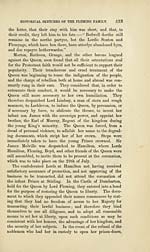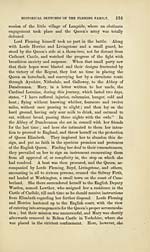Biggar and the House of Fleming
(564) Page 546
Download files
Complete book:
Individual page:
Thumbnail gallery: Grid view | List view

534 BIGGAR AND THE HOUSE OF FLEMING.
they declared that they would employ themselves, their kin
and friends, their servants and partakers, and their bodies and
lives, to put her Highness at liberty, as well as to procure the
punishment of the murderer of the King her husband, and the
safe preservation of the Prince her son. They also issued a
proclamation from the same place, calling upon all good sub-
jects to be ready on nine hours' warning to take arms for the
delivery of the Queen.
Queen Mary, by the aid of William Douglas, a boy of fifteen
or sixteen years of age, was at length enabled, on Sunday the
2d May 1568, to escape from Lochleven. She was received,
on landing from the boat that brought her ashore, by Lord
Seton and a party of his retainers, and conveyed to Niddrie
Castle, and next day to Hamilton. Intelligence of her escape
soon spread far and wide, and brought large accessions to her
ranks, so that in the course of a day or two her troops
amounted to 6000 men. A bond was drawn up and signed
by nine earls, nine bishops, eighteen lords, twelve abbots and
priors, and about a hundred other barons, pledging themselves
to protect the Queen and restore her to her rights. Lord
Fleming, of course, was among the number of those who signed
this bond. Mary's desire was to go with Lord Fleming to the
strong Castle of Dumbarton, where she could remain in safety
till she saw whether the nation in general would declare in
favour of her restoration, or whether it would be necessary for
her to abandon her kingdom, and retire once more to France.
The Hamiltons being anxious to gain an ascendancy in the
management of public affairs, thought that the presence of the
Queen was necessary to the accomplishment of their designs,
and therefore detained her several days in the Castle of Draffen.
The Earl of Murray had assembled a force of 4000 men at
Glasgow, and a request was sent to him by the lords at Hamil-
ton to agree to repone the Queen to her former status at the
head of the government ; but as he refused to do this, it was
resolved to conduct the Queen in a sort of warlike procession
to the Castle of Dumbarton, on the 13th of May, under the
direction of the Duke of Argyle, who had been appointed Com-
mander-in-chief of the Queen's forces. The Earl of Murray no
sooner learned that the Queen's army was on its march
towards Dumbarton, than he crossed the Clyde, and took pos-
they declared that they would employ themselves, their kin
and friends, their servants and partakers, and their bodies and
lives, to put her Highness at liberty, as well as to procure the
punishment of the murderer of the King her husband, and the
safe preservation of the Prince her son. They also issued a
proclamation from the same place, calling upon all good sub-
jects to be ready on nine hours' warning to take arms for the
delivery of the Queen.
Queen Mary, by the aid of William Douglas, a boy of fifteen
or sixteen years of age, was at length enabled, on Sunday the
2d May 1568, to escape from Lochleven. She was received,
on landing from the boat that brought her ashore, by Lord
Seton and a party of his retainers, and conveyed to Niddrie
Castle, and next day to Hamilton. Intelligence of her escape
soon spread far and wide, and brought large accessions to her
ranks, so that in the course of a day or two her troops
amounted to 6000 men. A bond was drawn up and signed
by nine earls, nine bishops, eighteen lords, twelve abbots and
priors, and about a hundred other barons, pledging themselves
to protect the Queen and restore her to her rights. Lord
Fleming, of course, was among the number of those who signed
this bond. Mary's desire was to go with Lord Fleming to the
strong Castle of Dumbarton, where she could remain in safety
till she saw whether the nation in general would declare in
favour of her restoration, or whether it would be necessary for
her to abandon her kingdom, and retire once more to France.
The Hamiltons being anxious to gain an ascendancy in the
management of public affairs, thought that the presence of the
Queen was necessary to the accomplishment of their designs,
and therefore detained her several days in the Castle of Draffen.
The Earl of Murray had assembled a force of 4000 men at
Glasgow, and a request was sent to him by the lords at Hamil-
ton to agree to repone the Queen to her former status at the
head of the government ; but as he refused to do this, it was
resolved to conduct the Queen in a sort of warlike procession
to the Castle of Dumbarton, on the 13th of May, under the
direction of the Duke of Argyle, who had been appointed Com-
mander-in-chief of the Queen's forces. The Earl of Murray no
sooner learned that the Queen's army was on its march
towards Dumbarton, than he crossed the Clyde, and took pos-
Set display mode to:
![]() Universal Viewer |
Universal Viewer | ![]() Mirador |
Large image | Transcription
Mirador |
Large image | Transcription
Images and transcriptions on this page, including medium image downloads, may be used under the Creative Commons Attribution 4.0 International Licence unless otherwise stated. ![]()
| Histories of Scottish families > Biggar and the House of Fleming > (564) Page 546 |
|---|
| Permanent URL | https://digital.nls.uk/94846050 |
|---|
| Description | A selection of almost 400 printed items relating to the history of Scottish families, mostly dating from the 19th and early 20th centuries. Includes memoirs, genealogies and clan histories, with a few produced by emigrant families. The earliest family history goes back to AD 916. |
|---|

